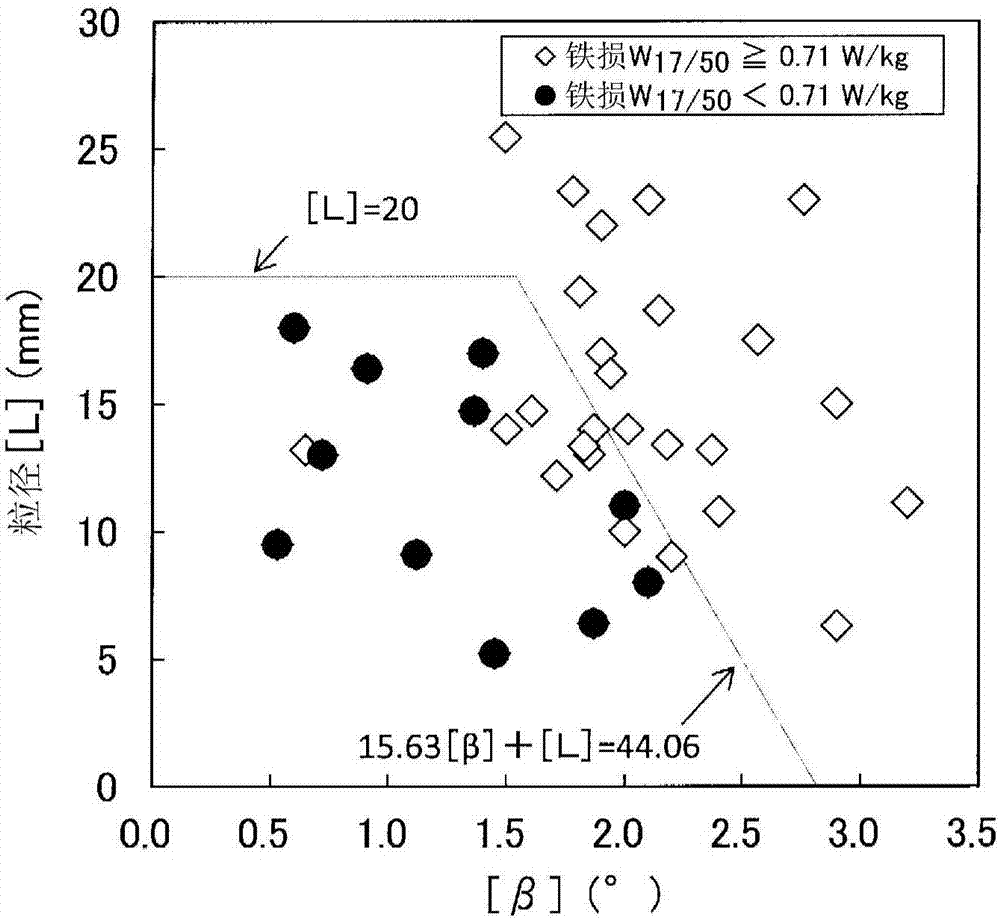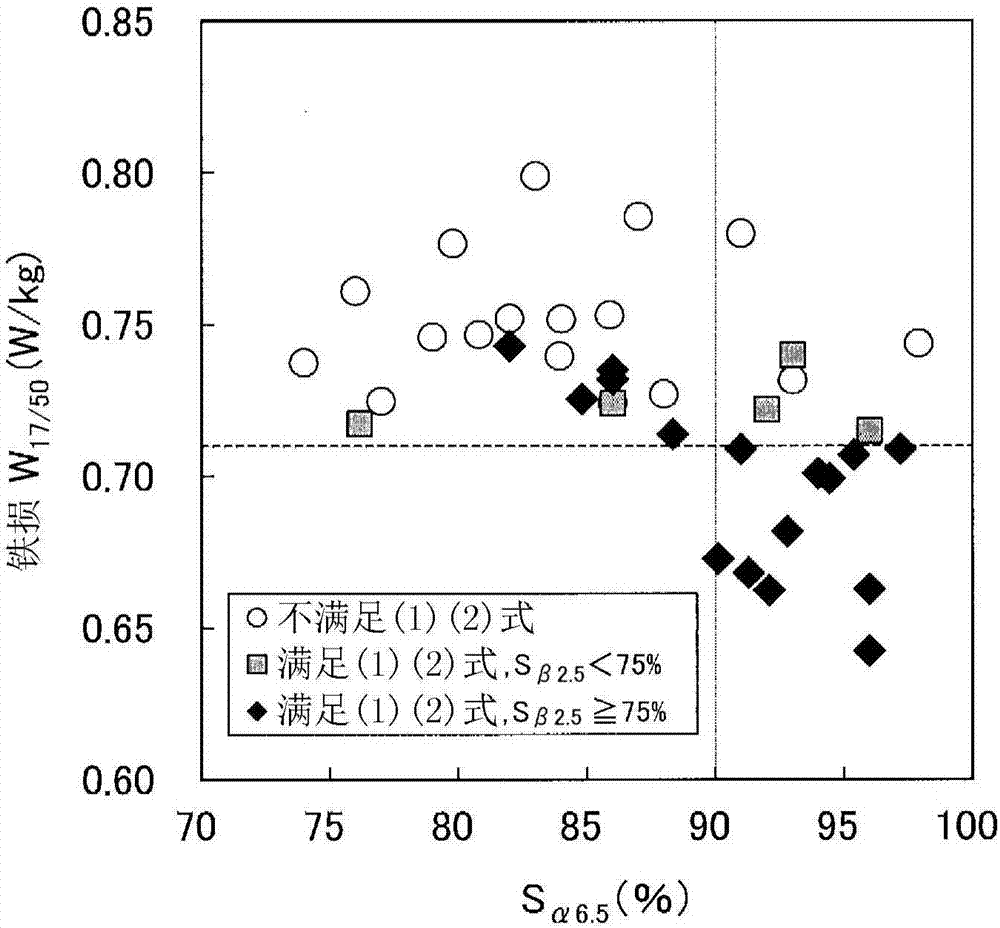Low-core-loss grain-oriented electromagnetic steel sheet and method for manufacturing same
A technology of electromagnetic steel sheet and manufacturing method, which is applied in the direction of manufacturing tools, circuits, magnetic objects, etc., can solve the problems of insufficient reduction of eddy current loss, large secondary recrystallization grains, etc., and achieve low iron loss and improved iron loss characteristics Effect
- Summary
- Abstract
- Description
- Claims
- Application Information
AI Technical Summary
Problems solved by technology
Method used
Image
Examples
Embodiment 1
[0105] Manufactured by continuous casting method containing C: 0.070% by mass, Si: 3.50% by mass, Mn: 0.12% by mass, Al: 0.025% by mass, and N: 0.012% by mass, the remainder consisting of Fe and unavoidable impurities The steel billet was reheated to a temperature of 1415° C. by induction heating, and then hot-rolled to obtain a hot-rolled sheet having a thickness of 2.5 mm. Next, after the hot-rolled sheet was annealed at 1000°C for 50 seconds, it was cold-rolled to an intermediate thickness of 1.9 mm, and after intermediate annealing at 1100°C for 25 seconds, it was finally cold-rolled. Refined into a cold-rolled plate with a plate thickness of 0.23 mm (final cold-rolled reduction rate of 87.9%).
[0106] Next, continuous linear grooves with a width of 70 μm and a depth of 28 μm were formed by electrolytic etching at a crossing angle of 75° with respect to the rolling direction on one surface of the cold-rolled sheet, with the interval d in the rolling direction being 3 mm. ...
Embodiment 2
[0118] Manufactured by continuous casting method containing C: 0.080% by mass, Si: 3.3% by mass, Mn: 0.12% by mass, Al: 0.025% by mass, and N: 0.012% by mass, with the remainder consisting of Fe and unavoidable impurities The steel billet is reheated to a temperature of 1400°C by induction heating, and then hot-rolled to make a hot-rolled sheet with a thickness of 2.6mm. mm intermediate thickness, after intermediate annealing at 1100°C for 30 seconds, final cold rolling with a reduction ratio of 89.4%, and a refined cold-rolled sheet with a thickness of 0.23mm.
[0119] Next, primary recrystallization annealing combined with decarburization annealing at 840° C. for 120 seconds was performed on the cold-rolled sheet. At this time, the temperature of 400°C during the heating process is maintained for 1.5 seconds, and then heated between 400°C and 700°C at a temperature increase rate of 150°C / s, and then the temperature from 700°C to 700°C is used as the soaking temperature. The...
Embodiment 3
[0127] Manufactured by continuous casting with a composition containing C: 0.080% by mass, Si: 3.40% by mass, Mn: 0.10% by mass, Al: 0.024% by mass, and N: 0.080% by mass, with the remainder consisting of Fe and unavoidable impurities The steel billet is reheated to a temperature of 1420°C by induction heating, and then hot-rolled to make a hot-rolled sheet with a thickness of 2.4mm. After annealing the hot-rolled sheet at 1100°C×40 seconds, it is cold-rolled to After performing intermediate annealing at 1100° C. for 25 seconds for a plate thickness of 1.7 mm, final cold rolling was performed at a reduction rate of 86.4%, and a cold-rolled plate with a plate thickness of 0.23 mm was refined.
[0128] Next, primary recrystallization annealing combined with decarburization annealing at 845° C. for 100 seconds was performed on the cold-rolled sheet. At this time, after performing the holding treatment at a temperature of 500°C for 3 seconds during the heating process, heating is ...
PUM
| Property | Measurement | Unit |
|---|---|---|
| Plate thickness | aaaaa | aaaaa |
| Plate thickness | aaaaa | aaaaa |
Abstract
Description
Claims
Application Information
 Login to View More
Login to View More - Generate Ideas
- Intellectual Property
- Life Sciences
- Materials
- Tech Scout
- Unparalleled Data Quality
- Higher Quality Content
- 60% Fewer Hallucinations
Browse by: Latest US Patents, China's latest patents, Technical Efficacy Thesaurus, Application Domain, Technology Topic, Popular Technical Reports.
© 2025 PatSnap. All rights reserved.Legal|Privacy policy|Modern Slavery Act Transparency Statement|Sitemap|About US| Contact US: help@patsnap.com



